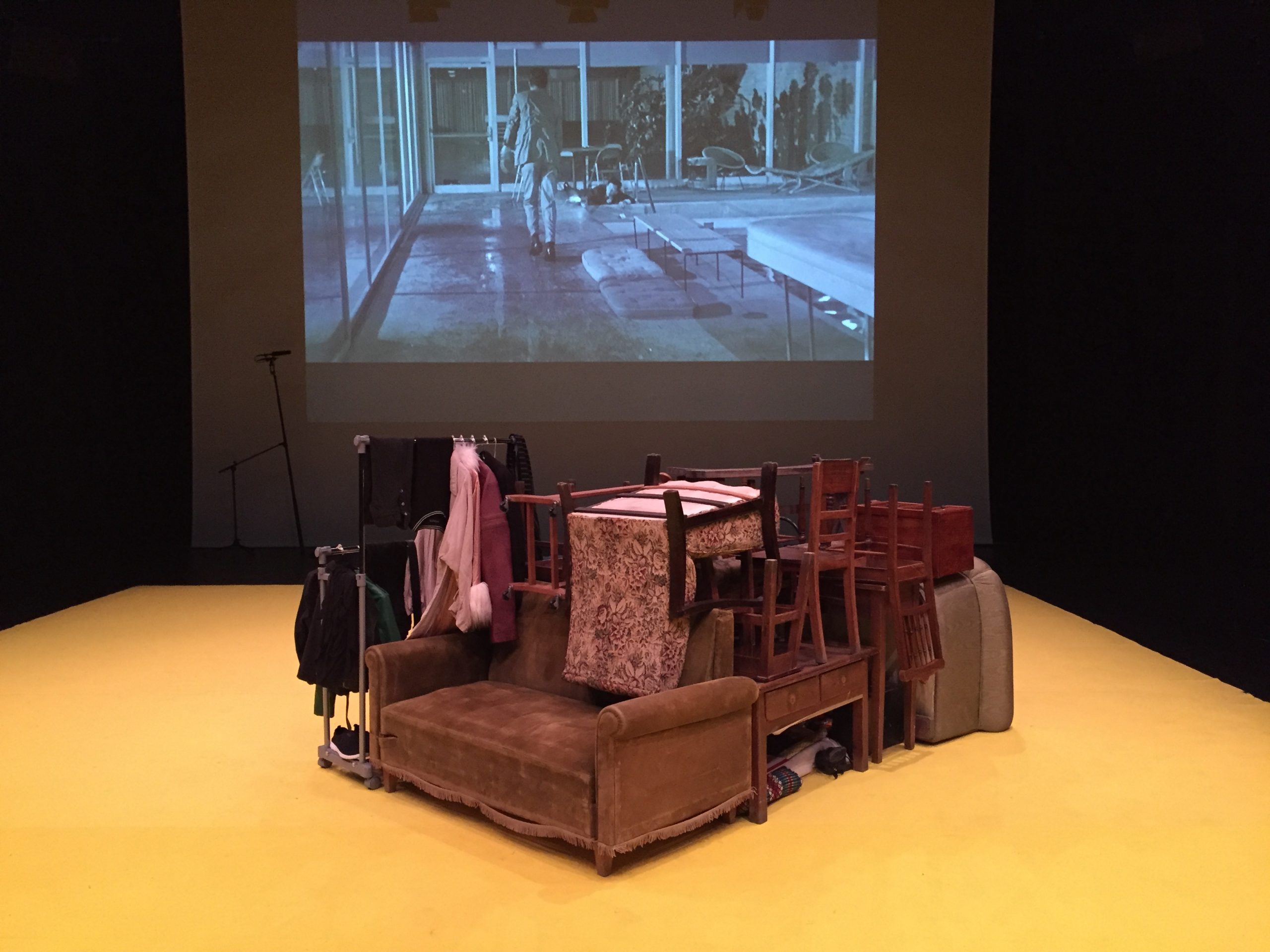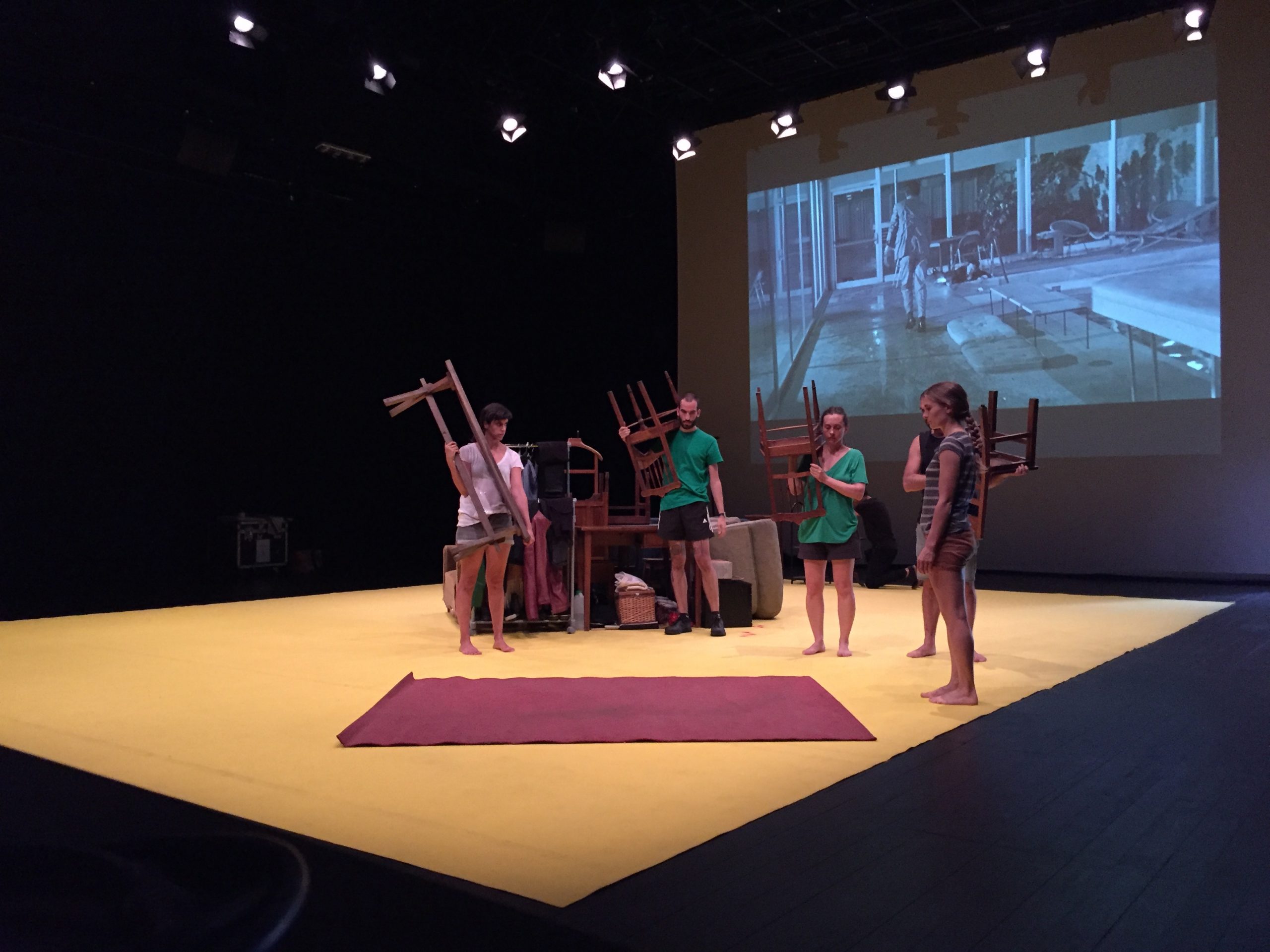from afar it was an island. De perto uma pedra / de longe era uma ilha. From up-close a stone
Concept and direction: João Fiadeiro
Co-direction: Leonardo Mouramateus and Carolina Campos
Performance and co-creation: Carolina Campos, Adaline Anobile, Márcia Lança (replacing Nuno Lucas), Iván Haidar and Julián Pacomio
Real time sound composition : João Bento
Lights: Leticia Skrycky
Space: João Fiadeiro – based on the scenic space of From Afar It Was An Island by Nadia Lauro (scenography), Gabriela Forman (costumes) and Bruno Bogarim (props).
Executive production: Sinara Suzin
Co-production (From afar it was an island): Alkantara, Festival DDD, Teatro Viriato, Teatro Avenida, Centre National de la Danse
Co-production (De perto, uma pedra): Temps d’Image, Atelier REAL
Support: Câmara Municipal de Lisboa / Polo Cultural Gaivotas_Boavista
“From afar it was an island” was financed by DGArtes
//

Veronika: What a strange way to make the bed.
Alexandre: I saw it in a film. That’s what films are for. To learn how to live, to learn how to make a bed.
The Mother and the Whore, by Jean Eustache

“De perto, uma pedra” (“From close up, a stone”) completes the phrase that could have been written by Bruno Munari after “From afar it was an island“, the title of a book that he wrote for children, and from where João Fiadeiro “borrowed” the name for the show he opened at the DDD18 Festival in Porto (commissioned by the Alkantara Festival).
This movement of re-visiting, in an “in situ” environment, a work originally designed for the stage, is an increasingly recurring practice in João Fiadeiro´s approach to creation. To retake and reassemble the same material, but now in an “unplugged” version, freeing it from the tyranny of the narrative, which the theatrical apparatus requires. His objective is also to offer the public an experience closer to the one a “visitor” would have, allowing an immersion and an involvement that the condition of “spectator” doesn’t welcome as organically. As if, in order to eliminate the expectation from the spectators it’s necessary to remove them from the “assigned place” (fixed, immovable and inert) which the audience normally occupies.
What we propose with “De perto, uma pedra. From up close, a stone“ is exactly what the phrase suggests: allow the spectator/visitor to look up close (and within) a work that was originally designed to be seen from afar (and from outside). In order to extract, from the island, a stone. That stone isn’t more nor less precious than the island from which it was removed. It is not part of a whole. It is a whole. Therefore, it doesn’t aim to explain, justify or illustrate the island-work. It simply aims to reaffirm (as Munari suggests) that all things are what they are (or what they become) depending on the perspective and scale in which we experience them.

Photo by Alipio Padilha
“De perto uma pedra” is choreographed with gestures stored by cinema, all “written” with these “words”, and with the tension that is kept inside these fragments. A set of more than a hundred films from which people who dress, walk, stop, wait, talk…were extracted. The raccord (match cut), common to cinematic language, is the principle capable of articulating relations between these gestures: someone fills a glass of water on their kitchen table CUT TO another someone who drops a glass of vodka on the bar counter. On the editing table, the raccord that would unify these two gestures would not hide the space and temporal jump that separates the two scenes, which may even be from two different films. In theater, however, we have the space and temporal unity of the stage, and we have the body that appropriates itself of the characters and unites the two scenes, without us noticing the exact moment in which one scene ends and another one begins. Gestures accumulate, the future is not predictable, and the past is not written. Gestures are contained in the present of their own presence, and yet they continue. In “De perto uma pedra” the gesture fixed by cinema is possessed by the phantom of the gesture of dance: oblivion.”
Leonardo Mouramateus
Document of the performance edited “side by side” with some of the filmes used to extract the gestures.
Compilation of the five “cinematographic scripts” that each dancer used to create their individual choreography.
List of filmes used to make the cinematographic scripts:
A Falecida, Brasil, 1965, Leon Hirszman
Aksharaya, 2005, Sri Lanka, Asoka Handagama
Al primo sopro di viento, Italia, 2002, Franco Piavoli
Angst vor der Angst, Alemanha, 1975, Rainer Werner Fassbinder
Aurora, 1927, EUA, F. W. Murnau
Banshun, Japão, 1949, Yasujiro Ozu
Benilde ou A Virgem Mãe, 1975, Portugal, Manoel de Oliveira
Bungalow, 2002, Alemanha, Ulrich Köhler
Camp de Thiaroye, 1988, Senegal, Ousmane Sembene
Catene, Itália, 1949, Raffaello Mattarazzo
Certain Women, 2016, EUA, Kelly Reichardt
Christine, UK, 1987, Alan Clarke
Chungking Express, 1994, Hong-Kong, Wong Kar-Wai
Dead Ringers, 1988, Canadá, David Cronenberg
Dial M for Murder, 1954, EUA, Alfred Hitchcock
Die bitteren Tränen der Petra von Kant, 1972, Alemanha, Rainer Werner Fassbinder
El Camino, Espanha, 1963, Ana Mariscal
El Castillo de la pureza, 1972, México, Arturo Ripstein
El Dirigible, Uruguai, 1994, Pablo Dotta
El Espíritu de la Colmena, 1973, Espanha, Victor Erice
En la ciudad de Sylvia, 2008, Espanha, José Luis Guerín
Ensayo de un crimen, México, 1955, Luis Buñuel
Evariste Galois, 1967, França, Alexandre Astruc
Faces, EUA, 1968, John Cassavetes
Film, EUA, 1965, Alan Schneider & Samuel Beckett
Filme Demência, 1986, Brasil, Carlos Reichenbach
Gamperaliya, 1963, Sri-Lanka, Lester James Peries
Gishiki, 1971, Japão, Nagisa Oshima
Gli occhi, la bocca, 1982, Itália, Marco Bellocchio
Idi i smotri, Rússia, 1985, Elem Klimov
Indagine su un cittadino al di sopra di ogni sospetto, 1970, Itália, Elio Petri
Je vous salue Marie, 1985, França, Jean-Luc Godard
Juan Moreira, 1973, Argentina, Leonardo Favio
Juízo, Brasil, 2007, Maria Augusta Ramos
Kōhī Jikō, Japan/Taiwan, 2003, Hou Hsiao-Hsien
Krylya, 1966, Rússia, Larisa Shepitko
L’ Aventura, Itália, 1960, Michelangelo Antonioni
La Coquille et le clergyman, França, 1928, Germaine Dulac
La Folie de Almayer, França, 1991, Chantal Akerman
La Libertad, Argentina, 2001, Lisandro Alonso
La Notte, 1961, Italia, Michelangelo Antonioni
La notti dei diavoli, 1972, Itália, Giorgio Ferroni
La prise de pouvoir par Louis XIV, 1966, França, Roberto Rossellini
La ragazza con la valigia, 1960, Itália, Valerio Zurlini
Last Days, 2005, EUA, Gus Van Sant
Le Livre de Marie, França, 1985, Anne-Marie Miéville
Le Mirage, França, 1991, Jean-Claude Guiguet
Les amants réguliers, França, 2005, Philippe Garrel
Les rendez-vous d’Anna, 1978, França, Chantal Akerman
Los Muertos, Argentina, 2004, Lisandro Alonso
M, Alemanha, 1931, Fritz Lang
Matka Joanna od Aniołów, Polônia, 1961, Jerzy Kawalerowicz
Messidor, 1979, Suíça/França, Alain Tanner
Monte Carlo, EUA, 1930, Ernst Lubitsch
Mr. Klein, 1976, França, Joseph Losey
My Brother’s Wedding, 1983, EUA, Charles Burnett
Naked Dawn, 1955, EUA, Edgar G. Ulmer
Nattvardsgästerna, Suécia, 1963, Ingmar Bergman
Near Dark, 1987, EUA, Kathryn Bigelow
Never Fear, 1949, EUA, Ida Lupino
Oasis, Coréia do Sul, 2002, Lee Chang-Dong
O caso dos Irmãos Naves, 1967, Brasil, Luiz Sérgio Person
O Fantasma, 2000, Portugal, João Pedro Rodrigues
O Sangue, Portugal, 1989, Pedro Costa
O Som da Terra a Tremer, Portugal, 1990, Rita Azevedo Gomes
O Território, 1981, Portugal, Raúl Ruiz
O Viajante, Brasil, 1999, Paulo César Saraceni
Palavra e Utopia, Portugal, 2000, Manoel de Oliveira
Pandora’s Box, 1930, Alemanha, G. W. Pabst
Permanent Vacation, 1980, EUA, Jim Jarmusch
Phenomena, 1985, Itália, Dario Argento
Planet of the vampires, 1965, Itália, Mario Bava
Possession, 1981, França, Andrzej Żuławski
Procès de Jeanne d’Arc, França, 1962, Robert Bresson
Proshu Slova, 1976, Rússia, Gleb Panfilov
Qingshaonian Nezha, 1992, Taiwan, Tsai Ming-Liang
Recordações da Casa Amarela, 1989, Portugal, João César Monteiro
Rope, 1948, EUA, Alfred Hitchcock
Río escondido, México, 1948, Emílio Fernandez
Samba Trouré, Burkina Faso, 1992, Ouedraogo
Sans toit ni loi, 1985, França, Agnés Varda
Schwarze Sunde, Alemanha, 1990, Jean-Marie Straub & Danièle Huillet
Steaming, 1985, UK, Joseph Losey
Suna no Onna, Japão, 1964, Hiroshi Teshigahara
Série Noire, 1979, França, Alain Corneau
Tabiate bijan, Irã, 1974, Sohrab Shahid Saless
Tau ban no hoi, Hong Kong, 1982, Ann Hui
Terra em transe, 1967, Brasil, Glauber Rocha
The Heartbreak Kid, 1972, EUA, Elaine May
The New York Ripper, 1992, Itália, Lucio Fulci
The Student Prince in Old Heidelberg, EUA, 1927, Ernst Lubitsch
The Territory, 1981, Portugal, Raúl Ruiz
Two friends, 1986, Austrália, Jane Campion
Ugetsu Monogatari, 1953, Japão, Kenji Mizoguchi
Ukigumo, Japão, 1955, Mikio Idrissa Naruse
Underworld U.S.A., 1961, EUA, Samuel Fuller
Uri Seonhui, 2013, Coréia do Sul, Hong Sang-Soo
US GO Home, França, 1994, Claire Denis
Vargtimmen, Suécia, 1968, Ingmar Bergman
Vidas Secas, 1963, Brasil, Nelson Pereira dos Santos
Vive L’amour, 1994, Taiwan, Tsai Ming-Liang
Vivre Sa vie, França, 1962, Jean-Luc Godard
Zhantai, China, 2000, Jia Zhangke
Él, 1953, México, Luis Buñuel
Últimos días de la víctima, 1982, Argentina, Adolfo Aristarain